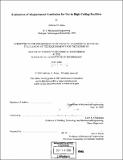Evaluation of displacement ventilation for use in high-ceiling facilities
Author(s)
Arens, Anthony D. (Anthony Daniel), 1971-
DownloadFull printable version (76.14Mb)
Other Contributors
Massachusetts Institute of Technology. Dept. of Mechanical Engineering.
Advisor
Leon G. Glicksman.
Terms of use
Metadata
Show full item recordAbstract
A experimental study was conducted to assess the performance of displacement ventilation in high ceiling facilities found in North America. Such areas include commercial and industrial manufacturing facilities often featuring high internal heat loads and contaminants associated with heat sources. These areas can range from 5 to 20 meters in height. Very little performance data exists for displacement ventilation installations in high-ceiling areas, particularly any which account for the influence of wall temperature. More performance data is needed to support design guidelines for displacement ventilation in such buildings. In this study, several experiments were conducted in a room equipped with both a high ceiling (6.5 meters) and a displacement ventilation system. The performance of the system in the presence of a variety of modeled loads was evaluated by use of strategically placed temperature, tracer gas, and velocity measurements. The modeled loads consisted of traditional person, computer, and lighting loads found in offices as well as simulators constructed to represent generic welding, engine exhaust and control panel enclosures in a manufacturing environment. Wall, floor, and ceiling temperatures were recorded in these experiments. The resulting data has been used to judge the suitability of displacement ventilation for a building equipped with each process. These experimental results are also used to test existing guidelines for displacement ventilation. Walls in this high ceiling room were found to have significant impact by generating large plume flows and contributing substantially to the total radiative incident loading to the floor. Experimental results could not justify the use of a constant temperature gradient assumption to estimate the temperature difference between head and foot levels. Plume modeling was found to work well in estimating the room stratification heights. Distance from the supply diffusers was found to have an impact upon air temperature near the floor as well as the temperature difference between the head and foot levels. A five node temperature model was found to work quite well in predicting five key temperature values in this high ceiling space. A design guideline was proposed for displacement ventilation in high spaces which incorporates the five node temperature model, plume modeling, and the fractional coefficient method. Results of the experimental data are being used to validate a CFD program previously validated for small office and classroom simulations with a ceiling height of 2.4 meters.
Description
Thesis (S.M.)--Massachusetts Institute of Technology, Dept. of Mechanical Engineering, 2000. Includes bibliographical references (p. 113, 1st group).
Date issued
2000Department
Massachusetts Institute of Technology. Department of Mechanical EngineeringPublisher
Massachusetts Institute of Technology
Keywords
Mechanical Engineering.